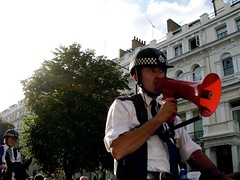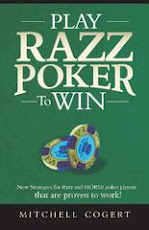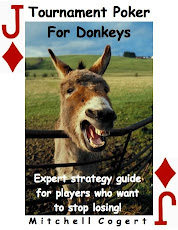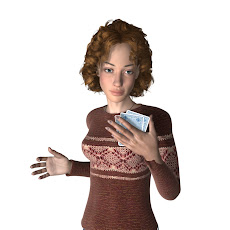 10 Specific Poker Tells You Can Cash-in On
10 Specific Poker Tells You Can Cash-in OnI may not be the best card player but I believe I am fairly good when it comes to reading my opponents. My ability to read players is about being able to differentiate when an opponent is strong or weak. Am I perfect at this skill? No. But, I have learned quite a bit that I want to share with you.
The one area that usually gets overlooked is the tells you provide your opponents. If you don't believe you
may signaling your hand strength to opponents, think again.
Recently, I moved all-in on the turn with a flush draw and an Ace overcard believing my opponent would fold since I showed strength pre-flop and flop, and calling my bet would cripple his stack. My opponent took quite a while to decide, but he did make the call. He said, "I know you're weak." I got lucky and I sucked out on the river. But, to me it meant I had a tell I needed to eliminate from my game.
One way to catch yourself giving a tell is to learn from these situations. Immediately think about what you did that gave away the strength of your hand. Perhaps at times you speak your bets and other times you are silent. Or, at times you slide your bet into the pot and other times toss them into the pot. Or, perhaps it was how you breathed after placing a big bet. It is not easy to find your own tells but you MUST do it to be a winning poker player.
Above I posted a picture of Hellmuth at the WSOP. The pose he is using is the one suggested by Joe Navarro to hide your tells during a hand. It may be something you should try.
Now, here are 10 specific poker tells you can cash-in on. Almost all of these tells are subconscious tells-- the player does not realize he is doing it. These subconscious tells often become habitual and indicate strength or weakness.
1. Preflop: Check the Player to your left
-The player to your left will often look at their cards when it is your turn to act and you check your hole cards. Pause when you do these and peek to see what he does when he plays a hand versus when he folds a hand.
It may be where he places a card protector. Or, it may be how he holds his cards in preparation of his action. Or, it may be how he leans slightly forward or back.
I can not stress enough how important it is to get in the habit of noticing your opponent's differences when folding or playing a hand pre-flop.
By the way, just because someone does not look at his hole cards until it is his turn at the start of a tournament does not mean that he will not start peeking an hour or more into the event. Keep checking.
2. Flop: 3 Cards of the Same Suit
-The most obvious tell on the flop is when the board comes with three cards of the same suit. 99% of the time if a player checks his hole cards after this flop, you can be sure he does not have a flush yet. He is checking in hopes that one of his hole cards is the same suit as those on the flop.
3. Speed of a Call on Flop
-A player who calls a bet quickly on the flop means that the decision to call is not a difficult one. These quick calls usually indicate the player has a piece of the board or is on a draw.
4. Speed of Bet on River When a Scare Card Hits
-Watch the player who has taken the lead in betting on the flop and turn, to see how quickly he bets on the river when a scare card hits. If the player does not miss a beat and bets, it usually means that he is not strong. Why? Because a scare card will make a player think for a while before deciding to bet or not.
In fact, there is a rhythm to the series of bets that simply does not make sense:
- flop: card on board, reach for chips, bet.
- turn: card on board, reach for chips, bet.
- river: SCARE card on board, reach for chips, bet. Huh?
5. Breathing after making a final bet
-I find it difficult to notice someone's breathing pattern. Instead, if I am trying to decide to call a big bet on the river or an all-in move, I will look at a person's chest. I need to pause about 10 seconds or so to see what happens. If after the pause, the person's chest starts to move in and out more noticeably, I take that as a sign of non-strength. It does not mean he is weak, but he is not strong.
6. Looking away after making a final bet
-This is almost a sign of strength. Let's say I find that the player is breathing more noticeably as above. If I have a good hand I am inclined to call. But, if the player looks away at any time after making the bet, I will use that as a more reliable indicator of strength. The reason is that a player who looks away usually does not want to give away any sign of the strength of his hand. Now, instead of calling, I will muck.
7. Torso Bobbing after making a final bet
-Navarro talks about how someone's feet is the most reliable poker tell. Well, I've never peeked under the table to check out an opponent's feet. But, if a player has happy feet, his torso will start bobbing quickly above the table. This is a sign of strength.
8. How bets are placed in the pot
-You may notice that the way you make a bet differs. Perhaps at times you slide in your bet, toss in your bet, toss in your bet with force, and/or bet palm down or palm up. Correct these mistakes and be consistent in how you place a bet in the pot.
Of course, you need to notice those same differences in how your opponents place a bet. These differences having meaning--strength or weakness. Make sure you have a consistent pattern before using these tells to make a decision.
9. Speech after making a bet or when making a bet
-A player who speaks after making a bet usually means strength. This player can not hold back his excitement of a strong hand and wants to tell everyone.
A player who speaks a bet may have meaning. Here, you need to see if there is a correlation of the strength of a hand when speaking versus not speaking a bet.
10. Posture after making a bet
-By posture I mean anything a player does with his hands and body that are different when strong versus weak. Let me share with you a couple of these:
- A player who put his hand over his mouth when he was strong but did not do this pose when he was weak
- A player who rested his head in his hand when he was strong but did not do this pose when he was weak
Finally, there is something about having a "feeling" when getting a read on your opponent. Trust your feelings above all else. Recently, I was in a hand where I had pocket Jacks and had to decide whether to call an all-in bet pre-flop. I knew my hand was better than my opponent but I had a feeling that the last player yet to act had a stronger hand than me. I dismissed this feeling and called. It was a mistake as that last player had pocket Queens.
Trust your feelings!










